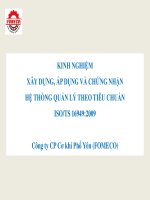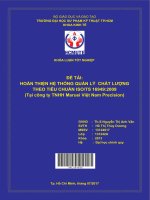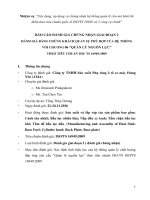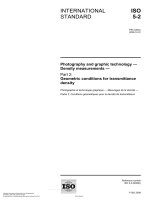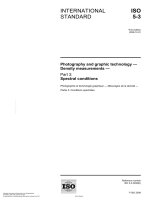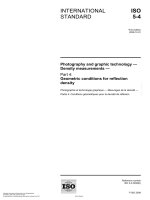Tiêu chuẩn iso 15877 3 2009
Bạn đang xem bản rút gọn của tài liệu. Xem và tải ngay bản đầy đủ của tài liệu tại đây (499.91 KB, 32 trang )
INTERNATIONAL
STANDARD
ISO
15877-3
Second edition
2009-03-15
Plastics piping systems for hot and cold
water installations — Chlorinated
poly(vinyl chloride) (PVC-C) —
Part 3:
Fittings
Systèmes de canalisations en plastique pour les installations d’eau
chaude et froide — Poly(chlorure de vinyle) chloré (PVC-C) —
--`,,```,,,,````-`-`,,`,,`,`,,`---
Partie 3: Raccords
Reference number
ISO 15877-3:2009(E)
Copyright International Organization for Standardization
Provided by IHS under license with ISO
No reproduction or networking permitted without license from IHS
© ISO 2009
Not for Resale
ISO 15877-3:2009(E)
PDF disclaimer
This PDF file may contain embedded typefaces. In accordance with Adobe's licensing policy, this file may be printed or viewed but
shall not be edited unless the typefaces which are embedded are licensed to and installed on the computer performing the editing. In
downloading this file, parties accept therein the responsibility of not infringing Adobe's licensing policy. The ISO Central Secretariat
accepts no liability in this area.
Adobe is a trademark of Adobe Systems Incorporated.
Details of the software products used to create this PDF file can be found in the General Info relative to the file; the PDF-creation
parameters were optimized for printing. Every care has been taken to ensure that the file is suitable for use by ISO member bodies. In
the unlikely event that a problem relating to it is found, please inform the Central Secretariat at the address given below.
COPYRIGHT PROTECTED DOCUMENT
© ISO 2009
All rights reserved. Unless otherwise specified, no part of this publication may be reproduced or utilized in any form or by any means,
electronic or mechanical, including photocopying and microfilm, without permission in writing from either ISO at the address below or
ISO's member body in the country of the requester.
ISO copyright office
Case postale 56 • CH-1211 Geneva 20
Tel. + 41 22 749 01 11
Fax + 41 22 749 09 47
Web www.iso.org
Published in Switzerland
--`,,```,,,,````-`-`,,`
ii
Copyright International Organization for Standardization
Provided by IHS under license with ISO
No reproduction or networking permitted without license from IHS
© ISO 2009 – All rights reserved
Not for Resale
ISO 15877-3:2009(E)
Contents
Page
Foreword............................................................................................................................................................ iv
Introduction ....................................................................................................................................................... vi
--`,,```,,,,````-`-`,,`,,`,`,,`---
1
Scope ..................................................................................................................................................... 1
2
Normative references ........................................................................................................................... 1
3
3.1
3.2
Terms, definitions and symbols.......................................................................................................... 2
Terms and definitions........................................................................................................................... 2
Symbols ................................................................................................................................................. 3
4
4.1
4.2
4.3
4.4
4.5
4.6
Material characteristics ........................................................................................................................ 3
General................................................................................................................................................... 3
Fitting material ...................................................................................................................................... 3
Evaluation of σLPL-values .................................................................................................................... 3
Thermal stability ................................................................................................................................... 7
Metallic material .................................................................................................................................... 8
Influence on water intended for human consumption...................................................................... 9
5
5.1
5.2
General characteristics ........................................................................................................................ 9
Appearance ........................................................................................................................................... 9
Opacity................................................................................................................................................... 9
6
6.1
6.2
6.3
6.4
6.5
Geometrical characteristics................................................................................................................. 9
General................................................................................................................................................... 9
Dimensions of fittings .......................................................................................................................... 9
Dimensions of sockets....................................................................................................................... 16
Dimensions of flange adaptors and flanges .................................................................................... 18
Dimensions of metallic fittings.......................................................................................................... 20
7
7.1
7.2
7.3
Mechanical characteristics ................................................................................................................ 20
Resistance to internal pressure ........................................................................................................ 20
Determination of free lengths............................................................................................................ 21
Derivation of the hydrostatic test pressure ..................................................................................... 22
8
Performance requirements ................................................................................................................ 23
9
Adhesives ............................................................................................................................................ 23
10
Sealing rings ....................................................................................................................................... 23
11
11.1
11.2
11.3
Marking ................................................................................................................................................ 24
General................................................................................................................................................. 24
Minimum required marking................................................................................................................ 24
Additional marking ............................................................................................................................. 24
Bibliography ..................................................................................................................................................... 25
iii
© ISO 2009 – All rights reserved
Copyright International Organization for Standardization
Provided by IHS under license with ISO
No reproduction or networking permitted without license from IHS
Not for Resale
ISO 15877-3:2009(E)
Foreword
ISO (the International Organization for Standardization) is a worldwide federation of national standards bodies
(ISO member bodies). The work of preparing International Standards is normally carried out through ISO
technical committees. Each member body interested in a subject for which a technical committee has been
established has the right to be represented on that committee. International organizations, governmental and
non-governmental, in liaison with ISO, also take part in the work. ISO collaborates closely with the
International Electrotechnical Commission (IEC) on all matters of electrotechnical standardization.
International Standards are drafted in accordance with the rules given in the ISO/IEC Directives, Part 2.
The main task of technical committees is to prepare International Standards. Draft International Standards
adopted by the technical committees are circulated to the member bodies for voting. Publication as an
International Standard requires approval by at least 75 % of the member bodies casting a vote.
Attention is drawn to the possibility that some of the elements of this document may be the subject of patent
rights. ISO shall not be held responsible for identifying any or all such patent rights.
ISO 15877-3 was prepared by the European Committee for Standardization (CEN) Technical Committee
CEN/TC 155, Plastics piping systems and ducting systems, in collaboration with ISO Technical Committee
ISO/TC 138, Plastics pipes, fittings and valves for the transport of fluids, Subcommittee SC 2, Plastics pipes
and fittings for water supplies, in accordance with the Agreement on technical cooperation between ISO and
CEN (Vienna Agreement).
--`,,```,,,,````-`-`,,`,,`,`,,`---
This part of ISO 15877 is part of a System Standard for plastics piping systems of a particular material for a
specified application. There are a number of such System Standards.
The System Standards are consistent with general standards on functional requirements and recommended
practices for installation.
This second edition cancels and replaces the first edition (ISO 15877-3:2003).
ISO 15877 consists of the following parts 1), under the general title Plastics piping systems for hot and cold
water installations — Chlorinated poly(vinyl chloride) (PVC-C):
⎯
Part 1: General
⎯
Part 2: Pipes
⎯
Part 3: Fittings
⎯
Part 5: Fitness for purpose of the system
⎯
Part 7: Guidance for the assessment of conformity [Technical Specification]
1) This System Standard does not incorporate a Part 4: Ancillary equipment or a Part 6: Guidance for installation. For
ancillary equipment, separate standards can apply. Guidance for installation of plastics piping systems made from different
materials, intended to be used for hot and cold water installations, is covered by ENV 12108 [4].
iv
Copyright International Organization for Standardization
Provided by IHS under license with ISO
No reproduction or networking permitted without license from IHS
© ISO 2009 – All rights reserved
Not for Resale
ISO 15877-3:2009(E)
At the date of publication of this part of ISO 15877, System Standards Series for piping systems of other
plastics materials used for the same application are the following:
ISO 15874 (all parts), Plastics piping systems for hot and cold water installations — Polypropylene (PP)
ISO 15875 (all parts), Plastics piping systems for hot and cold water installations ― Crosslinked polyethylene
(PE-X)
ISO 15876 (all parts), Plastics piping systems for hot and cold water installations ― Polybutylene (PB)
ISO 22391:— 2) (all parts), Plastics piping systems for hot and cold water installations ― Polyethylene of
raised temperature resistance (PE-RT)
2)
To be published. (Revisions of ISO 22391-1:2007, ISO 22391-2:2007, ISO 22391-3:2007, ISO 22391-5:2007.)
--`,,```,,,,````-`-`,,`,,`,`,,`---
v
© ISO 2009 – All rights reserved
Copyright International Organization for Standardization
Provided by IHS under license with ISO
No reproduction or networking permitted without license from IHS
Not for Resale
ISO 15877-3:2009(E)
The System Standard, of which this is Part 3, specifies the requirements for a piping system when made from
chlorinated poly(vinyl chloride) (PVC-C). The piping system is intended to be used for hot and cold water
installations and for heating system installations.
In respect of potential adverse effects on the quality of water intended for human consumption caused by the
product covered by this part of ISO 15877, the following are relevant.
a)
This part of ISO 15877 provides no information as to whether the product may be used without restriction
in any of the Member States of the EU or EFTA.
b)
It should be noted that, while awaiting the adoption of verifiable European criteria, existing national
regulations concerning the use and/or the characteristics of this product remain in force.
Requirements and test methods for materials and components, other than fittings, are specified in ISO 158771 and ISO 15877-2. Characteristics for fitness for purpose (mainly for joints) are covered in ISO 15877-5.
ISO/TS 15877-7 gives guidance for the assessment of conformity.
This part of ISO 15877 specifies the characteristics of the fittings.
vi
Copyright International Organization for Standardization
Provided by IHS under license with ISO
No reproduction or networking permitted without license from IHS
© ISO 2009 – All rights reserved
Not for Resale
--`,,```,,,,````-`-`,,`,,`,`,,`---
Introduction
INTERNATIONAL STANDARD
ISO 15877-3:2009(E)
Plastics piping systems for hot and cold water installations —
Chlorinated poly(vinyl chloride) (PVC-C) —
1
--`,,```,,,,````-`-`,,`,,`,`,,`---
Part 3:
Fittings
Scope
This part of ISO 15877 specifies the characteristics of fittings made from chlorinated poly(vinyl chloride) (PVCC) for piping systems intended to be used for hot and cold water installations within buildings for the
conveyance of water, whether or not intended for human consumption (domestic systems) and for heating
systems under design pressures and temperatures according to the class of application (see Table 1 of
ISO 15877-1:2009).
This part of ISO 15877 covers a range of service conditions (application classes) and design pressure classes.
For values of TD, Tmax and Tmal in excess of those in Table 1 of ISO 15877-1:2009, this part of ISO 15877
does not apply.
NOTE 1
It is the responsibility of the purchaser or specifier to make the appropriate selections from these aspects,
taking into account their particular requirements and any relevant national regulations and installation practices or codes.
It also specifies the parameters for the test methods referred to in this part of ISO 15877.
In conjunction with the other parts of ISO 15877, it is applicable to PVC-C fittings, their joints and joints with
components of PVC-C, other plastics and non-plastics materials intended to be used for hot and cold water
installations.
This part of ISO 15877 is applicable to fittings of the following types:
⎯
fittings for solvent cement joints;
⎯
mechanical fittings;
⎯
fittings with incorporated inserts.
NOTE 2
2
Fittings made from PVC-C are manufactured by injection-moulding.
Normative references
The following referenced documents are indispensable for the application of this document. For dated
references, only the edition cited applies. For undated references, the latest edition of the referenced
document (including any amendments) applies.
ISO 228-1, Pipe threads where pressure-tight joints are not made on the threads ― Part 1: Dimensions,
tolerances and designation
ISO 580, Plastics piping and ducting systems — Injection-moulded thermoplastics fittings ― Methods for
visually assessing the effects of heating
ISO 1167-1, Thermoplastics pipes, fittings and assemblies for the conveyance of fluids ― Determination of
the resistance to internal pressure ― Part 1: General method
1
© ISO 2009 – All rights reserved
Copyright International Organization for Standardization
Provided by IHS under license with ISO
No reproduction or networking permitted without license from IHS
Not for Resale
ISO 15877-3:2009(E)
ISO 1167-2, Thermoplastics pipes, fittings and assemblies for the conveyance of fluids ― Determination of
the resistance to internal pressure ― Part 2: Preparation of pipe test pieces
ISO 2536, Unplasticized polyvinyl chloride (PVC) pressure pipes and fittings, metric series ― Dimensions of
flanges
ISO 3126, Plastics piping systems ― Plastics components ― Determination of dimensions
ISO 7686, Plastics pipes and fittings ― Determination of opacity
ISO 9080, Plastics piping and ducting systems ― Determination of the long-term hydrostatic strength of
thermoplastics materials in pipe form by extrapolation
ISO 15877-1:2009, Plastics piping systems for hot and cold water installations ― Chlorinated poly(vinyl
chloride) (PVC-C) ― Part 1: General
ISO 15877-2:2009, Plastics piping systems for hot and cold water installations ― Chlorinated poly(vinyl
chloride) (PVC-C) ― Part 2: Pipes
ISO 15877-5, Plastics piping systems for hot and cold water installations ― Chlorinated poly(vinyl chloride)
(PVC-C) ― Part 5: Fitness for purpose of the system
EN 681-1, Elastomeric seals ― Material requirements for pipe joint seals used in water and drainage
applications ― Part 1: Vulcanized rubber
EN 727, Plastics piping and ducting systems ― Thermoplastics pipes and fittings ― Determination of Vicat
softening temperature (VST)
EN 1254-3, Copper and copper alloys ― Plumbing fittings ― Part 3: Fittings with compression ends for use
with plastics pipes
EN 10088-1, Stainless steels ― Part 1: List of stainless steels
EN 10226-1, Pipe threads where pressure tight joints are made on the threads ― Part 1: Taper external
threads and parallel internal threads ― Dimensions, tolerances and designation
3
Terms, definitions and symbols
For the purposes of this document, the terms, definitions and symbols given in ISO 15877-1 and the following
apply:
3.1
Terms and definitions
3.1.1
fitting for solvent cement joints
fitting in which the joint with the pipe or another component is made by means of an adhesive
3.1.2
Mechanical fittings
3.1.2.1
compression fitting
fitting in which the joint is made by the compression of a ring or sleeve on the outside wall of the pipe with or
without additional sealing elements and with internal support
--`,,```,,,,````-`-`,,`,,`,`,,`---
3.1.2.2
flanged fitting
fitting in which the pipe connection consists of two mating flanges, which are mechanically pressed together
and sealed by the compression of an elastomeric sealing element between them
2
Copyright International Organization for Standardization
Provided by IHS under license with ISO
No reproduction or networking permitted without license from IHS
© ISO 2009 – All rights reserved
Not for Resale
ISO 15877-3:2009(E)
3.1.2.3
flat seat union fitting
fitting in which the pipe connection consists primarily of two components, at least one of which normally
incorporates a flat sealing surface, which are mechanically pressed together by means of a screwed nut or
similar and sealed by the compression of an elastomeric sealing element between them
3.1.2.4
fitting with incorporated inserts
fitting in which the joint is made by means of connecting threads or other outlets, inserted in the injectionmoulded fitting body, combined with at least one solvent cement socket injection-moulded fitting body,
combined with at least one solvent cement socket
3.2
Symbols
ds1 inside diameter of the socket at entry
ds2 inside diameter of the socket at shoulder
d1
nominal diameter of the socket
d2
nominal diameter of the spigot
L
socket length
l0
free length
r
bending radius
Z
laying length (Z-length)
αn nominal angle of fitting
4
4.1
Material characteristics
General
The PVC-C material from which the fittings are made shall conform to this part of ISO 15877 and to the
relevant requirements of ISO 15877-1.
4.2
Fitting material
The material from which the fittings are made shall be a chlorinated poly(vinyl chloride) (PVC-C) resin to which
are added those additives that are needed to facilitate the manufacture of fittings conforming to this part of
ISO 15877.
When tested in accordance with the test method as specified in Table 1 or Table 2, as applicable, using the
indicated parameters, test pieces shall withstand the hydrostatic (hoop) stress without bursting or leakage.
4.3
Evaluation of σLPL-values
The fitting material should be evaluated in accordance with ISO 9080 or equivalent, where an internal
pressure test is made in accordance with ISO 1167-1 and ISO 1167-2 to find the σLPL-values. The σLPLvalues thus determined shall be at least as high as the corresponding values of the reference curves given in
Figure 1 and Figure 2 over the complete range of times.
--`,,```,,,,````-`-`,,`,,`,`,,`---
3
© ISO for
2009
– All rights reserved
Copyright International Organization
Standardization
Provided by IHS under license with ISO
No reproduction or networking permitted without license from IHS
Not for Resale
ISO 15877-3:2009(E)
NOTE 1
One equivalent way of evaluation is to calculate the σLPL-values for each temperature (e.g. for 20 °C, 60 °C
and 90 °C) individually.
Equation (1) and Equation (2) shall be used to determine the design stress, σDF, in the fitting material (see
Annex A of ISO 15877-2:2009), as well as the values of the hydrostatic stress, σF, of the fitting material
corresponding to the temperature and time control points given in Table 16 and Table 17.
log t = − 121,699 −
25 985
47 143,18
× logσ +
+ 63,035 11 × logσ
T
T
(1)
log t = − 72,662 4 −
15 253
29 245,14
× logσ +
+ 35,54 × logσ
T
T
(2)
NOTE 2
The reference curves in Figure 1 for PVC-C Type I in the temperature range of 10 °C to 90 °C are derived
from Equation (1)
NOTE 3
The reference curves in Figure 2 for PVC-C Type II in the temperature range of 10 °C to 95 °C are derived
from Equation (2)
NOTE 4
Resistance to Tmal of PVC-C Type I material is verified by testing in accordance with Annex A of
ISO 15877-1:2009.
PVC-C Type I:
Temperatures 20 °C; 60 °C to 70 °C; 90 °C;
PVC-C Type I:
Time intervals 10 h to 100 h, 100 h to 1 000 h,1 000 h to 8 760 h and above 8 760 h;
PVC-C Type II:
Temperatures 20 °C; 60 °C to 70 °C; 95 °C;
PVC-C Type II:
Time intervals 10 h to 100 h, 100 h to 1 000 h, 1 000 h to 8 760 h and above 8 760 h;
In tests lasting more than 8 760 h, once no failure is reached at a stress and time at least on or above the
reference line, any time after that can be considered as the failure time. Testing should be carried out in
accordance with ISO 1167-1.
Design coefficients used for fitting materials are found in Annex A of ISO 15877-2:2009. Conformance to the
reference lines should be demonstrated by plotting the individual experimental results on the graph. At least
97,5 % of them should lie on or above the reference line.
4
Copyright International Organization for Standardization
Provided by IHS under license with ISO
No reproduction or networking permitted without license from IHS
© ISO 2009 – All rights reserved
Not for Resale
--`,,```,,,,````-`-`,,`,,`,`,,`---
To demonstrate conformance to the reference lines, pipe samples shall be tested at the following
temperatures and at various hoop stresses such that, at each of the temperatures given, at least three failure
times fall in each of the following time intervals:
ISO 15877-3:2009(E)
Key
X1 time to fracture, expressed in hours
X2 time to fracture, expressed in years
Y hydrostatic stress, expressed in megapascals
Figure 1 — Reference curves for the expected hydrostatic strength of PVC-C Type I fitting material
--`,,```,,,,````-`-`,,`,,`,`,,`---
5
© ISO for
2009
– All rights reserved
Copyright International Organization
Standardization
Provided by IHS under license with ISO
No reproduction or networking permitted without license from IHS
Not for Resale
ISO 15877-3:2009(E)
Key
X1 time to fracture, expressed in hours
X2 time to fracture, expressed in years
Y hydrostatic stress, expressed in megapascals
Figure 2 — Reference curves for the expected hydrostatic strength of PVC-C Type II fitting material
6
--`,,```,,,,````-`-`,,`,,`,`,,`---
Copyright International Organization for Standardization
Provided by IHS under license with ISO
No reproduction or networking permitted without license from IHS
© ISO 2009 – All rights reserved
Not for Resale
ISO 15877-3:2009(E)
4.4
Thermal stability
When tested in accordance with the test methods specified in Table 1 or Table 2, as applicable, using the
indicated parameters, the material in tubular form shall have physical characteristics conforming to the
requirements given in Table 1 or Table 2, as applicable.
Table 1 — Thermal stability of PVC-C Type I
Characteristic
Vicat softening
temperature (VST)
Effects of
heating
Thermal stability
by hydrostatic
pressure testing
a
Requirements
VST W 103 °C
a
b
Test parameters
Shall conform to EN 727
Test temperature
Heating time for:
e u 3 mm
3 mm < e u 10 mm
10 mm < e u 20 mm
Number of test pieces
No bursting or
Sampling procedure
leakage during the Type of end caps
test period
Orientation of test piece
Diameter
Free length
Type of test
Test temperature
Hydrostatic (hoop) stress
Test period
Preparation of test pieces
Number of test pieces
Test method
EN 727
(150 ± 2) °C
(15 ± 1) min
(30 ± 1) min
(60 ± 1) min
3
c
Method A of
ISO 580
Air oven
ISO 1167-1
Types A or B
Vertical
dn u 50 mm
l0 W 3dn
Water-in-air
90 °C
2,85 MPa
17520 h
Shall conform to 7.1.2
3
The fitting shall not show any crack, delamination, blister or sign of weld-line splitting.
b
No surface damage in the area of any injection point shall penetrate deeper than 20 % of the wall thickness, e, at any point. Outside
the area of any injection point, no surface damage shall occur. For sprue gating, the area of the injection point shall be calculated using
a radius R = 0,3dn. For fittings moulded by end-gating techniques, e.g. ring or diaphragm methods, the gating area shall be a cylindrical
portion with a length of L = 0,3dn (see Figure 3). Any cracks or delamination in the wall of the fitting adjacent to the injection area,
parallel to the axis of the fitting, shall not penetrate to a depth in axial direction of more than 20 % of the nominal diameter.
c
The sampling procedure is not specified. For guidance, see ISO/TS 15877-7 [3].
--`,,```,,,,````-`-`,,`,,`,`,,`---
7
© ISO 2009 – All rights reserved
Copyright International Organization for Standardization
Provided by IHS under license with ISO
No reproduction or networking permitted without license from IHS
Not for Resale
ISO 15877-3:2009(E)
Table 2 — Thermal Stability of PVC-C Type II
Characteristic
Vicat softening
temperature (VST)
Effects of
heating
VST W 115 °C
a
b
Thermal stability
by hydrostatic
pressure testing
a
Requirements
Test parameters
Test method
Shall conform to EN 727
Test temperature
Heating time for:
e u 3 mm
3 mm < e u 10 mm
10 mm < e u 20 mm
Number of test pieces
No bursting or
Sampling procedure
leakage during the Type of end caps
test period
Orientation of test piece
Diameter
Free length
Type of test
Test temperature
Hydrostatic (hoop) stress
Test period
Preparation of test pieces
Number of test pieces
EN 727
(150 ± 2) °C
Method A of
ISO 580
Air oven
(15 ± 1) min
(30 ± 1) min
(60 ± 1) min
3
c
ISO 1167-1
Types A or B
Vertical
dn u 50 mm
l0 W 3dn
Water-in-air
100°C
2,14 MPa
8760 h
Shall conform to 7.1.2
3
The fitting shall not show any crack, delamination, blister or sign of weld-line splitting.
b
No surface damage in the area of any injection point shall penetrate deeper than 20 % of the wall thickness, e, at any point. Outside
the area of any injection point, no surface damage shall occur. For sprue gating, the area of the injection point shall be calculated using
a radius R = 0,3dn. For fittings moulded by end-gating techniques, e.g. ring or diaphragm methods, the gating area shall be a cylindrical
portion with a length of L = 0,3dn (see Figure 3). Any cracks or delamination in the wall of the fitting adjacent to the injection area,
parallel to the axis of the fitting, shall not penetrate to a depth in axial direction of more than 20 % of the nominal diameter.
c
--`,,```,,,,````-`-`,,`,,`,`,,`---
4.5
The sampling procedure is not specified. For guidance, see ISO/TS 15877-7 [3].
a) sprue-gate
b) diaphragm-gate
c) ring-gate
Figure 3 — Injection gating areas
Metallic material
Metallic material for fittings intended to be used with components conforming to ISO 15877 shall conform to
the requirements given in EN 1254-3 or EN 10088-1, as applicable.
8
Copyright International Organization for Standardization
Provided by IHS under license with ISO
No reproduction or networking permitted without license from IHS
© ISO 2009 – All rights reserved
Not for Resale
ISO 15877-3:2009(E)
4.6
Influence on water intended for human consumption
The material from which the fittings are made shall conform to ISO 15877-1.
5
General characteristics
5.1
Appearance
When viewed without magnification, the internal and external surfaces of fittings shall be smooth, clean and
free from scoring, cavities and other surface defects to an extent that would prevent conformance with this
part of ISO 15877. The material shall not contain visible impurities. Slight variations in the appearance of the
colour shall be permitted.
Each end of a fitting shall be square to its axis.
5.2
Opacity
PVC-C fittings that are declared to be opaque shall not transmit more than 0,2 % of visible light when tested in
accordance with ISO 7686.
6
Geometrical characteristics
6.1
General
Dimensions shall be measured in accordance with ISO 3126.
NOTE
Figure 4 to Figure 10 cover schematic sketches only, to indicate the relevant dimensions. They do not
necessarily represent the manufactured components.
6.2
6.2.1
Dimensions of fittings
Nominal diameter(s)
The nominal diameter(s), dn, of a fitting shall correspond to and be designated by the nominal outside
diameter(s) of the pipe(s) conforming to ISO 15877-2 for which they are designed.
6.2.2
Wall thicknesses
The wall thickness, e, of the fitting body shall conform to Table 3 in relation to the pipe series S.
NOTE
Compared with the wall thickness of the corresponding pipe conforming to ISO 15877-2, the wall thickness, e,
of the fitting body is increased by the factor 1,35.
--`,,```,,,,````-`-`,,`,,`,`,,`---
9
© ISO 2009 – All rights reserved
Copyright International Organization for Standardization
Provided by IHS under license with ISO
No reproduction or networking permitted without license from IHS
Not for Resale
ISO 15877-3:2009(E)
Table 3 — Wall thicknesses of fitting bodies
Dimensions in millimetres
Nominal
diameter
Pipe series
S 6,3
S5
Minimum wall
dn
S4
thickness a
emin
12
14
16
20
25
1,9
1,9
1,9
2,1
2,6
1,9
1,9
2,1
2,6
3,2
1,9
2,2
2,5
3,2
3,8
32
40
50
63
75
3,3
4,1
5,0
6,4
7,6
4,0
5,0
6,3
7,9
9,2
4,9
6,1
7,6
9,6
11,4
90
110
125
140
160
9,1
11,0
12,5
14,0
16,0
11,1
13,5
15,4
17,2
19,8
13,7
16,7
18,9
21,2
24,2
a
The values are rounded up to the first place of the decimals (i.e. the
nearest 0,1 mm).
6.2.3
Angles
The preferred nominal angle, αn, of non-straight fittings is 45° and 90°.
6.2.4
Threads
Threads used for jointing shall conform to EN 10226-1. Where a thread is used as a fastening thread for
jointing an assembly (e.g. union nuts), it shall conform to ISO 228-1 except that these requirements need not
apply to the threads used by the manufacturer to join component parts of a fitting together.
6.2.5
Laying lengths (Z-lengths)
For the following types of injection-moulded fittings, the Z-lengths shall be calculated using one of the
Equations (3) to (11), as applicable, where α is the angle of the fitting and r is the bending radius:
dn
+1
2
a)
90° elbow (see Figure 4 and Table 4)
Z=
b)
45° elbow (see Figure 4 and Table 4)
α⎞
⎛d
Z = ⎜ n × tan ⎟ + 1
2
2⎠
⎝
c)
90° tee (see Figure 4 and Table 4)
Z=
d)
45° tee (see Figure 4 and Table 4)
α⎞
⎛d
Z = ⎜ n × cot ⎟ + t
2⎠
⎝ 2
dn
+1
2
(3)
(4)
(3)
(5)
--`,,```,,,,````-`-`,,`,,`,`,,`---
10
Copyright International Organization for Standardization
Provided by IHS under license with ISO
No reproduction or networking permitted without license from IHS
© ISO 2009 – All rights reserved
Not for Resale
ISO 15877-3:2009(E)
α⎞
⎛d
Z 1 ≈ ⎜ n × tan ⎟ + 1
2⎠
⎝ 2
(6)
with dn u 90, 110, 125, 140, 160 and t = 3, 4, 6, 6, 7
e)
bends (see Figure 5 and Table 5)
Z ≈ r = 2d n
(7)
f)
reducing bushes, long type (see Figure 6):
— with conical sockets (see Table 6)
Z con = 0,3 × ( d 2 − d1 ) + L d 2
(8)
— with cylindrical sockets (see Table 7)
Z cyl = 0,75 d 2 + 6
(9)
reducing bushes, short type (see Figure 7):
— with conical sockets (see Table 8)
Z con = L d 2 − L d1
(10)
⎛d
⎞ ⎛d
⎞
Z cyl = ⎜ 2 + 6 ⎟ − ⎜ 1 + 6 ⎟
⎝ 2
⎠ ⎝ 2
⎠
(11)
g)
— with cylindrical sockets (see Table 9)
The calculated values of the Z-lengths are given in Table 4 to Table 9, as applicable. These values may be
adopted by the manufacturer. The manufacturer shall state the exact values for the Z-lengths in his
documents (e.g. catalogues).
a) 90° elbow
b) 45° elbow
c) 90° tee
d) 45° tee
e) socket
Figure 4 — Z-lengths of elbows, tees and couplers (double-sockets)
--`,,```,,,,````-`-`,,`,,`,`,,`---
11
© ISO 2009 – All rights reserved
Copyright International Organization for Standardization
Provided by IHS under license with ISO
No reproduction or networking permitted without license from IHS
Not for Resale
ISO 15877-3:2009(E)
Table 4 — Calculated laying lengths (Z-lengths) and related tolerances of elbows, tees and couplers
(double-sockets)
Dimensions in millimetres
Nominal
diameter
Type of fitting
90° elbow
45° elbow
90° tee
45° tee
Double-socket
Calculated Z-length and recommended deviations
dn
Z
Z
Z
Z
Z1
Z
12
7±1
3,5 ± 1
7±1
—
—
3±1
14
8±1
4±1
8±1
—
—
3±1
16
9±1
4,5 ± 1
9±1
—
—
3±1
6 +−21
7 +−21
8 +−21
10 +−21
12 +−21
14 +−21
17 +−21
20 +−31
24 +−31
27 +−31
30 +−41
35 +−41
3±1
11 ± 1
5±1
11 ± 1
27 ± 3
25
13,5 +−1,2
1
6 +−1,2
1
13,5 +−1,2
1
33 ± 3
32
17 +−1,6
1
7,5 +−1,6
1
17 +−1,6
1
42 +−43
40
21+−21
9,5 +−21
21+−21
51+−53
50
26 +−2,5
1
11,5 +−2,5
1
26 +−2,5
1
63 +−63
63
32,5 +−3,2
1
14 +−3,2
1
32,5 +−3,2
1
79 +−73
75
38,5 +−41
16,5 +−41
38,5 +−41
94 +−93
90
46 +−51
19,5 +−51
46 +−51
112 +−11
3
110
56 +−61
24 +−61
56 +−61
137 +−13
4
125
63,5 +−61
27 +−61
63,5 +−61
157 +−15
4
140
71+−71
30 +−71
71+−71
175 +−17
5
160
81+−81
34 +−81
81+−81
200 +−20
6
3 +−1,2
1
3 +−1,6
1
3 +−21
3 +−21
3 +−21
4 +−21
5 +−21
6 +−31
6 +−31
8 +−31
8 +−41
--`,,```,,,,````-`-`,,`,,`,`,,`---
20
Figure 5 — Dimensions of injection-moulded bends
12
Copyright International Organization for Standardization
Provided by IHS under license with ISO
No reproduction or networking permitted without license from IHS
© ISO 2009 – All rights reserved
Not for Resale
ISO 15877-3:2009(E)
Table 5 — Calculated laying lengths (Z-lengths) and related tolerances of
injection-moulded bends
Dimensions in millimetres
Nominal
diameter
Calculated laying length and
related tolerances
Nominal
diameter
Calculated laying length and
related tolerances
dn
Z
dn
Z
12
24 ± 1
63
126 +−3,2
1
14
28 ± 1
75
150 +−41
16
32 ± 1
90
180 +−51
20
40 ± 1
110
220 +−61
25
50 +−1,2
1
125
250 +−61
32
64 +−1,6
1
140
280 +−71
40
80 +−21
160
320 +−61
50
100 +−2,5
1
—
—
practical application
--`,,```,,,,````-`-`,,`,,`,`,,`---
Figure 6 — Dimensions of reducing bushes, long type, and example of application
13
© ISO 2009 – All rights reserved
Copyright International Organization for Standardization
Provided by IHS under license with ISO
No reproduction or networking permitted without license from IHS
Not for Resale
ISO 15877-3:2009(E)
Table 6 — Calculated laying lengths (Z-lengths) and related tolerances of
reducing bushes, long type, with conical sockets
Dimensions in millimetres
Nominal
diameter of
the socket
Nominal diameter of the spigot, d2
20
25
32
40
50
63
75
90
110
Calculated laying length, Z, and related tolerances
d1
±1
± 1,5
±2
16
21
28
35
—
—
—
—
—
—
20
—
27
34
41
—
—
—
—
—
25
—
—
32
40
49
—
—
—
—
32
—
—
—
38
46
59
—
—
—
40
—
—
—
—
44
57
71
—
—
50
—
—
—
—
—
54
68
84
—
63
—
—
—
—
—
—
64
80
102
75
—
—
—
—
—
—
—
77
99
90
—
—
—
—
—
—
—
—
94
Table 7 — Calculated laying lengths (Z-lengths) and related tolerances of
reducing bushes, long type, with cylindrical sockets
Dimensions in millimetres
Nominal
diameter of
the socket
Nominal diameter of the spigot, d2
20
25
32
40
50
63
75
90
110
125
140
160
--`,,```,,,,````-`-`,,`,,`,`,,`---
Calculated laying length, Z, and related tolerances
d1
±1
± 1,5
±2
14
21
25
30
—
—
—
—
—
—
—
—
—
16
21
25
30
36
—
—
—
—
—
—
—
—
20
—
25
30
36
44
—
—
—
—
—
—
—
25
—
—
30
36
44
54
—
—
—
—
—
—
32
—
—
—
36
44
54
62
—
—
—
—
—
40
—
—
—
—
44
54
62
74
—
—
—
—
50
—
—
—
—
—
54
62
74
88
—
—
—
63
—
—
—
—
—
—
62
74
88
100
—
—
75
—
—
—
—
—
—
—
74
88
100
111
—
90
—
—
—
—
—
—
—
—
88
100
111
126
110
—
—
—
—
—
—
—
—
—
100
111
126
125
—
—
—
—
—
—
—
—
—
—
111
126
140
—
—
—
—
—
—
—
—
—
—
—
126
14
Copyright International Organization for Standardization
Provided by IHS under license with ISO
No reproduction or networking permitted without license from IHS
© ISO 2009 – All rights reserved
Not for Resale
